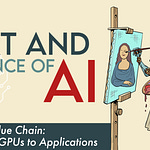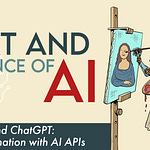In this episode we delve into the world of generative AI with a focus on language modeling. We explore how text is transformed into semantically meaningful data through the use of vector embeddings, providing an in-depth look at the mechanics behind AI models like Open AI’s GPT-3. Discover the complexities of semantic relationships in language, the role of mathematical concepts such as vector algebra in AI, and the advancements that make generative AI both powerful and conversational.
🎧 Listen to the episode
Watch or listen to the episode on YouTube, Spotify, Apple Podcasts, Substack (right on top of this page), or copy the RSS link into your favorite podcast player!
⏰ Chapters
00:00: Preview and intro
01:01: Text embeddings and vector algebra
13:10: From embeddings to language models: GPT
24:20: From GPT to ChatGPT: Reinforcement Learning with Human Feedback
🧠 Key concepts
Text is encoded in AI models via word embeddings
Vector algebra is used to translate semantic relationships to mathematical relationships
Language models predict the next word in a sequence
GPT is fundamentally a language model
Reinforcement Learning with Human Feedback is used to turn a language model like GPT into a chatbot like ChatGPT
🔗 References
Nikhil Maddirala: https://www.linkedin.com/in/nikhilmaddirala/
Piyush Agarwal: https://www.linkedin.com/in/piyush5/
📓 Detailed notes
Text Encoding Complexity: Encoding text for AI is more complex than images due to the need to preserve semantic relationships. This is achieved using word embeddings, which transform words into vectors that capture their meanings.
Word Embeddings and Vectors: Word embeddings allow AI models to understand the context in which words appear, enabling them to perform tasks like classification and prediction by maintaining relationships between words.
Vector algebra: Concepts from vector algebra are crucial in understanding and developing AI models. These mathematical principles help in mapping words to vectors and manipulating them to derive meaningful outputs.
Language Models: A language model's primary function is to predict the next word in a sequence, a task it performs by learning from vast amounts of training data. This prediction capability is the foundation of generative AI applications.
Training and Inference: The training phase of AI involves finding the right parameters for the model, which is computationally intensive. Inference, or the application phase, uses these parameters to generate predictions, which is less computationally demanding.
Human Feedback in AI: ChatGPT incorporates reinforcement learning with human feedback to improve conversational quality, making it more context-aware and user-friendly.














Share this post